The Ulster Defence Regiment (UDR) was an infantry regiment of the British Army established in 1970, with a comparatively short existence ending in 1992. Raised through public appeal, newspaper and television advertisements, their official role was the "defence of life or property in Northern Ireland against armed attack or sabotage" but unlike troops from Great Britain they were never used for "crowd control or riot duties in cities". At the time the UDR was the largest infantry regiment in the British Army, formed with seven battalions plus another four added within two years.

The Military Medal (MM) was a military decoration awarded to personnel of the British Army and other arms of the armed forces, and to personnel of other Commonwealth countries, below commissioned rank, for bravery in battle on land. The award was established in 1916, with retrospective application to 1914, and was awarded to other ranks for "acts of gallantry and devotion to duty under fire". The award was discontinued in 1993, when it was replaced by the Military Cross, which was extended to all ranks, while other Commonwealth nations instituted their own award systems in the post war period.
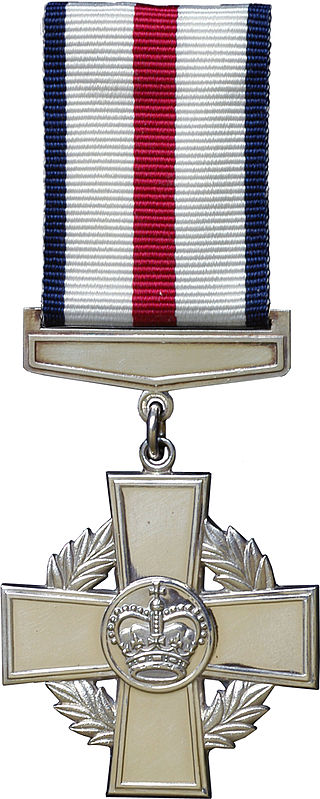
The Conspicuous Gallantry Cross (CGC) is a second level military decoration of the British Armed Forces. Created in 1993 and first awarded in 1995, it was instituted after a review of the British honours system to remove distinctions of rank in the awarding of gallantry decorations. The Victoria Cross is the only higher combat gallantry award presented by the United Kingdom.
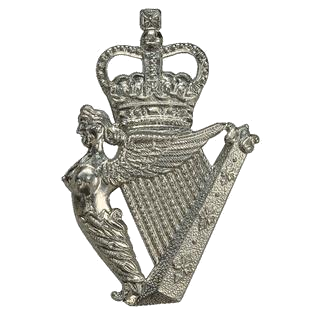
The Royal Irish Regiment is an infantry regiment of the British Army. The regiment was founded in 1992 through the amalgamation of the Royal Irish Rangers and the Ulster Defence Regiment. Their oldest predecessor, the 27th Regiment of Foot, was first raised in June 1689 to fight in the Williamite War in Ireland. Other notable regiments in their lineage include the Royal Inniskilling Fusiliers, Royal Irish Rifles and the Royal Irish Fusiliers.
The Canadian Forces' Decoration is a Canadian award bestowed upon members of the Canadian Armed Forces who have completed twelve years of military service, with certain conditions. By convention, it is also given to the governor general of Canada upon his or her appointment, which includes the title of Commander-in-Chief in and over Canada. The decoration is awarded to all ranks, who must have a good record of conduct during the final eight years of claimed service.
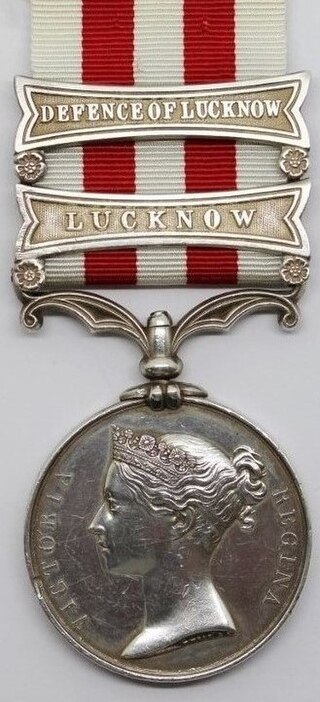
The Indian Mutiny Medal was a campaign medal approved in August 1858, for officers and men of British and Indian units who served in operations in suppression of the Indian Rebellion of 1857.

The General Service Medal, is a campaign medal of the United Kingdom introduced in 1962 to replace both the General Service Medal (1918), as awarded to the Army and RAF, and the Naval General Service Medal (1915). The 1962 GSM was awarded until 2007, when it was replaced by the Operational Service Medal. In 2015 the General Service Medal (2008) was introduced.

The 11th (Craigavon) Battalion, Ulster Defence Regiment was formed from companies of the 2nd Battalion Ulster Defence Regiment and the 3rd Battalion Ulster Defence Regiment in 1972. In 1991 under the reductions planned in Options for Change by the British Army, it again amalgamated with 2 UDR to form the 2nd/11th Battalion Ulster Defence Regiment.

3rd Battalion, Ulster Defence Regiment was formed in 1970 as part of the seven original battalions specified in The Ulster Defence Regiment Act 1969, which received Royal Assent on 18 December 1969 and was brought into force on 1 January 1970. It was, along with the rest of the regiment, amalgamated with the Royal Irish Rangers in 1992 to form the Royal Irish Regiment.

5th Battalion, Ulster Defence Regiment was formed in 1970 as part of the seven original battalions specified in The Ulster Defence Regiment Act 1969, which received Royal Assent on 18 December 1969 and was brought into force on 1 January 1970. It was, along with the rest of the regiment, amalgamated with the Royal Irish Rangers in 1992 to form the Royal Irish Regiment.

The 7th/10th Battalion, Ulster Defence Regiment was formed in 1984 as a result of an amalgamation between the 7th Battalion Ulster Defence Regiment and the 10th Battalion Ulster Defence Regiment. The resultant 7/10 UDR was subsumed into the Royal Irish Rangers in 1992 as part of the amalgamation which formed the Royal Irish Regiment.

The 10th Battalion, Ulster Defence Regiment was formed in 1972 from elements of the 7th Battalion, Ulster Defence Regiment creating a second battalion in Belfast. It was again amalgamated with 7 UDR in 1984 to form the 7th/10th Battalion, Ulster Defence Regiment.

The Elizabeth Cross is a form of recognition given to the recognised next of kin of members of the British Armed Forces killed in action or as a result of a terrorist attack after the Second World War. It bears the name of Queen Elizabeth II.
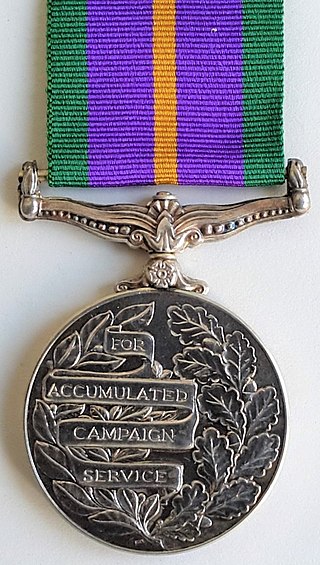
The Accumulated Campaign Service Medal and the Accumulated Campaign Service Medal 2011 are medals awarded by King Charles III to members of his Armed Forces to recognise long campaign service. The original Accumulated Campaign Service Medal, instituted in January 1994, was awarded to holders of the General Service Medal (1962) who had completed 36 months of accumulated campaign service. The replacement Accumulated Campaign Service Medal 2011 is now currently awarded to holders of various campaign service medals who have completed 720 days of campaign service.
Brigadier Henry Joseph Patrick Baxter was an Irish born fourth generation soldier who overcame the handicap of being blind in one eye to join the army and rose to command one of the largest and most controversial regiments in the British Army.
The Northern Ireland Home Service Medal is a long service medal awarded to members of the Ulster Defence Regiment and its successor the Royal Irish Regiment. Established in 1992, the medal is awarded for 12 years of long and efficient service. Clasps are awarded for six subsequent years of qualifying service. The medal replaced the Ulster Defence Regiment Medal.
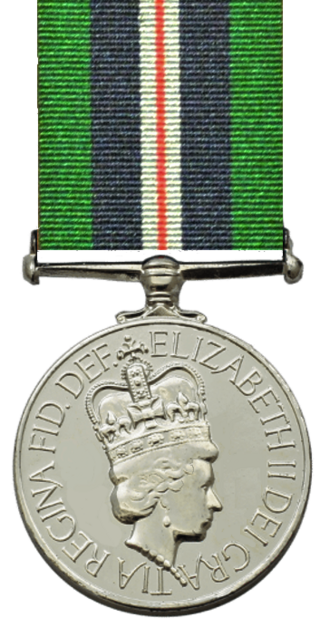
The Northern Ireland Prison Service Medal was established by Royal Warrant on 15 January 2002. Agreed to in principle by the Queen in 2000, the medal was created to recognise Northern Ireland Prison Service personnel who had served in the "difficult and often dangerous conflict" during the Troubles. This included the murder of 28 prison staff, with dozens more wounded and many forced to move home due to intimidation.
The Medal for Long Service and Good Conduct (Ulster Defence Regiment) was a long service medal of the United Kingdom, established in 1982. The medal was awarded to full-time members of the Ulster Defence Regiment upon the completion of 15 years of efficient service.
Colonel Sir James Dennis Compton Faulkner was a Northern Irish officer, who served in the Royal Navy and British Army. He was the Regimental Colonel of the Ulster Defence Regiment from 1982 to 1992.








